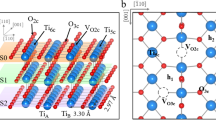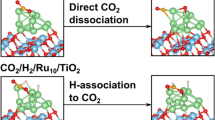Abstract
Following our strategy to analyze the metal–support interaction, we present periodic DFT calculations for adsorption of metal atoms on a perfect rutile TiO2(110) surface (at low coverage, θ = 1/3) to investigate the interaction of an individual metal atom, M, with TiO2 and its consequence on the coadsorption of H and CO over M/TiO2. M under investigation varies in a systematic way from K to Zn. It is found that the presence of the support decreases or increases the strength of M–H or M–CO interaction according to the nature of M. The site of the adsorption for H and the formation of HCO/M also depend on M. From the left- to the right-hand side of the period, C and O both interact while O progressively detaches from M. On the contrary, for M = Fe–Cu, CO dissociation is more likely to happen. For CO and H coadsorption, two extreme cases emerge: For Ni, the hydrogen adsorbed should easily move on the support and CO dissociation is more likely. For Ti or Sc, H is easily coadsorbed with CO on the metal and CO hydrogenation could be the initial step.







Similar content being viewed by others
Notes
Note that a “minimalistic or reductionist approach,” reducing the number of variables, is not only a tool for theoretical analysis; according to Somorjai, it allows designing the right experiment (An American scientist, 2013 Archway publishing Bloomington).
Note that the formal electron transfer referring to oxidation states may be hardly visible through charge analysis [14]. The site of adsorption (on O dianion) confirms the cationic feature. In cases of unpaired electrons, the reduction is often better revealed by spin analysis [1, 30]. Gold on reduced surfaces (O defective, hydrogenated surface) is the exception [1, 30].
We never see Cu2+.
References
Helali Z, Markovits A, Minot C, Abderrabba M (2013) Chem Phys Lett 565:45
Khodakov AY, Chu W, Fongarland P (2007) Chem Rev 107(5):1692
Ciobica IM, van Santen RA (2003) J Phys Chem B 107(16):3808
Sellers H, Gislason J (1999) Surf Sci 426(2):147
Souza Monteiro R, Paes LW, Carneiro JWDM, Aranda DA (2008) J Cluster Sci 19(4):601
Jedidi A, Markovits A, Minot C, Abderrabba M, Van Hove MA (2014) PCCP 16:20703
Jedidi A, Norelus W, Markovits A, Minot C, Illas F, Abderrabba M (2013) Theor Chem Acc 133(2):1
Markvoort AJ, van Santen RA, Hilbers PAJ, Hensen EJM (2012) Angew Chem Int Ed 51(36):9015
van Santen RA, Markvoort AJ, Filot IAW, Ghouri MM, Hensen EJM (2013) PCCP 15(40):17038
Elahifard MR, Jigato MP, Niemantsverdriet JW (2012) ChemPhysChem 13(1):89
Bond GC (1983) Spec Period Report 6:27
Tauster SJ, Fung SC, Garten RL (1978) J Am Chem Soc 100(1):170
Calzado CJ, San Miguel MA, Sanz JF (1999) J Phys Chem B 103(3):480
Giordano L, Pacchioni G, Bredow T, Sanz JF (2001) Surf Sci 471(1–3):21
Gomes JRB, Illas F, Hernández NC, Márquez A, Sanz JF (2002) Phys Rev B 65(12):125414
Grau-Crespo R, Hernandez NC, Sanz JF, de Leeuw NH (2007) J Phys Chem C 111(28):10448
Helali Z, Markovits A, Minot C, Abderrabba M (2012) Struct Chem 23(5):1309
Hernández NC, Graciani J, Márquez A, Sanz JF (2005) Surf Sci 575(1–2):189
Hernández NC, Sanz JF (2002) J Phys Chem B 106(44):11495
San Miguel MA, Calzado CJ, Sanz JF (2001) J Phys Chem B 105(9):1794
Wörz AS, Heiz U, Cinquini F, Pacchioni G (2005) J Phys Chem B 109(39):18418
Márquez A, Graciani J, Sanz J (2010) Theor Chem Acc 126(3–4):265
Fan L, Fujimoto K (1994) J Catal 150(1):217
Bracey JD, Burch R (1984) J Catal 86(2):384
Haller G, Resasco DE (1989) Adv Catal 36:173
Tsubaki N, Fujimoto K (2003) Top Catal 22(3):325
Fernandez S, Alikhani E, Markovits A, Skalli MK, Minot C (2009) Chem Phys Lett 475(4–6):215
Fernandez S, Markovits A, Fuster F, Minot C (2007) J Phys Chem C 111(18):6781
Sanz JF, Márquez A (2007) J Phys Chem C 111(10):3949
Fernandez SB, Markovits A, Minot C (2008) J Phys Chem C 112(36):14010
Kresse G, Hafner J (1994) Phys Rev B 49(20):14251
Kresse G, Furthmüller J (1996) Comput Mater Sci 6:15
Kresse G, Furthmüller J (1996) J Phys Rev B 54:11169
Kresse G, Hafner J (1993) Phys Rev B 48:13115
Blochl PE (1994) Phys Rev B 50(24):17953
Kresse G, Joubert D (1999) Phys Rev B 59(3):1758
Bredow T, Giordano L, Cinquini F, Pacchioni G (2004) Phys Rev B 70(3):035419
Hameeuw KJ, Cantele G, Ninno D, Trani F, Iadonisi G (2006) J Chem Phys 124(2):024708
Pilme J, Silvi B, Alikhani ME (2003) J Phys Chem A 107(22):4506
Chatt J, Duncanson LA (1953) J Chem Soc 2939
Dewar MJS (1951) Bull Soc Chim Fr 18(3–4):C71
Nguyen_Trong A (2007) Frontier orbitals: a practical manual
Nguyen_Trong A, Eisenstein O (1977) New J Chem 1(1):61
Moruzzi VL, Williams AR, Janak JF (1977) Phys Rev B 15(6):2854
Ayed O, Manceron L, Silvi B (1988) J Phys Chem 92(1):37
Leconte J, Markovits A, Skalli MK, Minot C, Belmajdoub A (2002) Surf Sci 497(1–3):194
Shustorovich E (1986) Surf Sci Rep 6(1):1
Shustorovich E (1990) The bond-order conservation approach to chemisorption and heterogeneous catalysis: applications and implications. In: Eley DD, Pines H, Weisz PB (eds) Advances in catalysis, vol 37. Academic Press, p 101. http://dx.doi.org/10.1016/S0360-0564(08)60364-8
Kaupp M, Stoll H, Preuss H (1990) J Comput Chem 11:1029
Adamo C, Barone V (1999) J Chem Phys 110(13):6158
Koukounas C, Kardahakis S, Mavridis A (2005) J Chem Phys 123(7):074327
Alikhani ME, Manceron L (2015) J Mol Spectrosc (in press)
Acknowledgments
We are grateful to CMCU-PHC (09G 1212) and the Institut Français de Cooperation in Tunisia (IFC) for their financial support. The authors thank GENCI and CCRE for computing facilities.
Author information
Authors and Affiliations
Corresponding author
Rights and permissions
About this article
Cite this article
Helali, Z., Jedidi, A., Markovits, A. et al. Reactivity of transition metal atoms supported or not on TiO2(110) toward CO and H adsorption. Theor Chem Acc 134, 50 (2015). https://doi.org/10.1007/s00214-015-1652-4
Received:
Accepted:
Published:
DOI: https://doi.org/10.1007/s00214-015-1652-4




